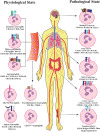Neutrophil sub-types in maintaining immune homeostasis during steady state, infections and sterile inflammation
- PMID: 37212866
- PMCID: PMC10201050
- DOI: 10.1007/s00011-023-01737-9
Neutrophil sub-types in maintaining immune homeostasis during steady state, infections and sterile inflammation
Abstract
Introduction: Neutrophils are component of innate immune system and a) eliminate pathogens b) maintain immune homeostasis by regulating other immune cells and c) contribute to the resolution of inflammation. Neutrophil mediated inflammation has been described in pathogenesis of various diseases. This indicates neutrophils do not represent homogeneous population but perform multiple functions through confined subsets. Hence, in the present review we summarize various studies describing the heterogeneous nature of neutrophils and associated functions during steady state and pathological conditions.
Methodology: We performed extensive literature review with key words 'Neutrophil subpopulations' 'Neutrophil subsets', Neutrophil and infections', 'Neutrophil and metabolic disorders', 'Neutrophil heterogeneity' in PUBMED.
Results: Neutrophil subtypes are characterized based on buoyancy, cell surface markers, localization and maturity. Recent advances in high throughput technologies indicate the existence of functionally diverse subsets of neutrophils in bone marrow, blood and tissues in both steady state and pathological conditions. Further, we found proportions of these subsets significantly vary in pathological conditions. Interestingly, stimulus specific activation of signalling pathways in neutrophils have been demonstrated.
Conclusion: Neutrophil sub-populations differ among diseases and hence, mechanisms regulating formation, sustenance, proportions and functions of these sub-types vary between physiological and pathological conditions. Hence, mechanistic insights of neutrophil subsets in disease specific manner may facilitate development of neutrophil-targeted therapies.
Keywords: Auto immune diseases; Granulopoiesis; Heterogeneity; Infections; Neutrophils.
© 2023. The Author(s).
Conflict of interest statement
The authors declare no competing interests.
The authors declare that they have no conflict of interest.
Figures




Similar articles
-
Neutrophil heterogeneity: Bona fide subsets or polarization states?J Leukoc Biol. 2018 May;103(5):829-838. doi: 10.1002/JLB.3RI0917-361R. Epub 2018 Feb 20. J Leukoc Biol. 2018. PMID: 29462505 Review.
-
Neutrophil Homeostasis and Emergency Granulopoiesis: The Example of Systemic Juvenile Idiopathic Arthritis.Front Immunol. 2021 Dec 13;12:766620. doi: 10.3389/fimmu.2021.766620. eCollection 2021. Front Immunol. 2021. PMID: 34966386 Free PMC article. Review.
-
Targeting Neutrophils for Promoting the Resolution of Inflammation.Front Immunol. 2022 Mar 16;13:866747. doi: 10.3389/fimmu.2022.866747. eCollection 2022. Front Immunol. 2022. PMID: 35371088 Free PMC article. Review.
-
The diverse roles of neutrophils from protection to pathogenesis.Nat Immunol. 2024 Dec;25(12):2209-2219. doi: 10.1038/s41590-024-02006-5. Epub 2024 Nov 20. Nat Immunol. 2024. PMID: 39567761 Review.
-
Kinetics of Neutrophil Subsets in Acute, Subacute, and Chronic Inflammation.Front Immunol. 2021 Jun 24;12:674079. doi: 10.3389/fimmu.2021.674079. eCollection 2021. Front Immunol. 2021. PMID: 34248955 Free PMC article.
Cited by
-
Interaction of low-density neutrophils with other immune cells in the mechanism of inflammation.Mol Med. 2025 Apr 9;31(1):133. doi: 10.1186/s10020-025-01187-5. Mol Med. 2025. PMID: 40205584 Free PMC article. Review.
-
Early and opposing neutrophil and CD4 T cell responses shape pulmonary tuberculosis pathology.J Exp Med. 2025 Oct 6;222(10):e20250161. doi: 10.1084/jem.20250161. Epub 2025 Jul 30. J Exp Med. 2025. PMID: 40736456 Free PMC article.
-
Proteomic Characterization of 1000 Human and Murine Neutrophils Freshly Isolated From Blood and Sites of Sterile Inflammation.Mol Cell Proteomics. 2024 Nov;23(11):100858. doi: 10.1016/j.mcpro.2024.100858. Epub 2024 Oct 11. Mol Cell Proteomics. 2024. PMID: 39395581 Free PMC article.
-
Neutrophil heterogeneity and aging: implications for COVID-19 and wound healing.Front Immunol. 2023 Nov 28;14:1201651. doi: 10.3389/fimmu.2023.1201651. eCollection 2023. Front Immunol. 2023. PMID: 38090596 Free PMC article. Review.
-
Role of Neutrophil Extracellular Traps in Health and Disease Pathophysiology: Recent Insights and Advances.Int J Mol Sci. 2023 Oct 31;24(21):15805. doi: 10.3390/ijms242115805. Int J Mol Sci. 2023. PMID: 37958788 Free PMC article. Review.
References
-
- Joshi MB, Ahamed R, Hegde M, Nair AS, Ramachandra L, Satyamoorthy K. Glucose induces metabolic reprogramming in neutrophils during type 2 diabetes to form constitutive extracellular traps and decreased responsiveness to lipopolysaccharides. Biochim Biophys Acta Mol Basis Dis. 2020;1866:165940. doi: 10.1016/j.bbadis.2020.165940. - DOI - PubMed
Publication types
MeSH terms
Grants and funding
LinkOut - more resources
Full Text Sources

